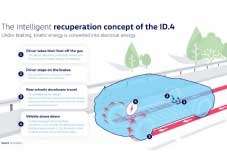
Regenerative braking or energy recovery when decelerating greatly boosts the range of any electric vehicle. However, what should happen when drivers of electric vehicles take their foot off the right-most pedal is a difficult, philosophical question. Should the electric drive motor act as a generator, converting kinetic energy into electrical energy, or should it run without generating electrical energy, so that the vehicle’s momentum is used for coasting?
According to Volkswagen (VW), manufacturer and models vary in their approaches. Some EVs recover energy whenever a driver lifts off the right-most pedal after acceleration. For its new ID.4, its first all-electric SUV and the brand’s first electric world car, VW priorities coasting because conversion of energy inevitably leads to losses. This applies to the D (Drive) position, the default mode, which is automatically activated upon start-up.
The coasting function, whereby drivers take their foot off the accelerator pedal early on, makes for relaxed and predictable driving. Should drivers want to decelerate more, they step on the brake pedal and activate brake energy recuperation. During the majority of everyday braking manoeuvres of up to around 0.25 g of deceleration—the electric drive motor performs the braking alone, while the electric brake servo only activates the friction brakes in situations that demand more stopping power. The transition from generator-based to hydraulic braking goes almost unnoticed, thanks to highly accurate and swift brake and drive system control. These systems also make sure that the rear wheels, where brake energy recuperation takes place, always have a sufficient amount of grip.
Each ID.4 features predictive Eco Assistance as standard. It analyses data from the navigation system and vehicle sensors to provide drivers with effective support in driving efficiently and in a relaxed way. Once the ID.4 approaches a low-speed area, such as urban environments, junctions and bends, Eco Assistance notifies drivers to take their foot off the accelerator pedal. From this moment on, the system manages optimum coasting and energy recovery without drivers having to intervene. The car responds similarly when it approaches a vehicle ahead that is travelling at a lower speed.
Drivers can use the gear selector rocker switch to change from the D position to B (Brake) at any time. In this mode, the ID.4’s drive almost always recovers energy during lifting off, but not all the way to a standstill. The limit has been set at 0.13 g, enough for clearly noticeable deceleration that won’t confuse drivers of conventional internal combustion engine vehicles: intuitive operation is one of the vehicles’ greatest strengths, VW concludes.
